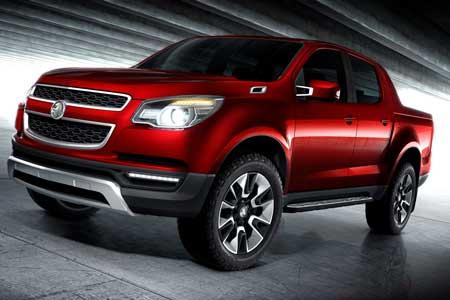| With the Sydney Motor Show held less than a year ago – we went there only eight months ago - I thought it wasn’t going to be easy for the organisers to attract really new products to the Melbourne event at the end of June. “How wrong can you be?” asks JOHN OXLEY. OK, it’s not Paris or Frankfurt or Tokyo, but the Australian International Motor Show Melbourne edition, was a big eye-opener, and a great indicator, if we needed it, that the recession is on its way out. I called this the “Melbourne edition” offering because last year it was decided the AIMS would alternate between the two cities year-on-year, thus ensuring both of them get top billing and maximum support from exhibitors. From the viewpoint of 4WD enthusiasts there were a number of brand-new products on display, most of them centred on the utility area. Given that we’ve already had a pretty good introduction to the next generation Ford Ranger and Mazda BT-50 siblings, due here around November, arguably the most important 4WD model at the show has got to be the next generation Holden Colorado, due to be launched in the first quarter of next year. Although the Aussies made lots of noise about “Australian inspired design”, what seems to have happened is that the Holden designers have taken a Brazilian-designed Chevrolet and added a few Holden touches. But, that said, it IS a nice looking truck! The vehicles, which are larger than the current Isuzu-based Colorados, will be built in Thailand and the top-of-the line model will get a 2.8-litre turbo diesel engine, which will probably be the only engine available here in 4WD form if the new model follows current trends. At this stage no details about the power plant are available, but it is likely it will come from Italy’s VM Motori, in which Holden’s holding company General Motors has a half share, Fiat owning the other half. VM Motori currently makes a 2.8-litre four-cylinder Euro 5 compliant turbo-diesel which powers the Jeep Wrangler and Cherokee, and produces 147 kW/460 Nm. Suspension is similar to the current Colorado’s, with torsion bars up front and a leaf sprung rear, and dimensions are length 5,339 mm; width 1,901 mm; height 1,789 mm, wheelbase 3,096 mm. Says Holden NZ boss Jeff Murray: “Clearly this is a show vehicle; however, the basic proportions and design are pretty much what you can expect for the production version.” Although, as mentioned, we’ve seen double cab versions of the next Ford Ranger and the next Mazda BT-50, Mazda took some of the limelight with the global reveal of a different version, a “Freestyle Cab” which is Mazda speak for a “2+2” ute. This uses the same “suicide door” concept as current BT-50 versions to offer a combination of seating for four, a wide pillar-less door opening, and a large carrying capacity. On each side of the cabin a front-hinged door and a rear hinged panel both open to provide a 1,408 mm-wide opening that makes for easy entry to and exit from either the front or rear seats. Rear-seat comfort has been improved, too, with longer cushions with better thigh support and stable fitment of child seats while the seatback height has been increased by 128 mm. The rear seat cushions can be removed, and with the rear access panels opening to an angle of nearly 90 degrees, give the option of loading and storing cargo into the rear seating area. Compared to the current Freestyle Cab version overall height has increased by 84 mm to 1,706 mm, width by 135 mm to 1,85 0mm and length has increased by 204 mm to 5,373 mm. The wheelbase has grown by 220 mm. Interior space is also increased all round, with rear passengers getting 796 mm of leg room. The 3.2-litre 5-cylinder turbo-diesel engine for top models goes head-on against the new Colorado with 147 kW/470 Nm. It’s mated to a new 6-speed transmission and will be capable of towing 3,350 kg braked. Mazda also showed a tricked-up version of the new vehicle with after-market front bumper/bull bars combination, knobbly tyres, and side rails. On the Ford stand a double cab version of the Ranger was on display, showing the final production design which was close to the “concept” shown at Sydney. It has the same running gear as the Mazda. While we’re still talking about utes, the Toyota Hilux continues to be New Zealand’s top seller in this segment, so news of an upgraded version is important. Sales are expected to start here in November. Toyota has done a major facelift to the front end of the iconic model, with all-new bodywork from the A-pillar forward, including a revised front bumper, fresh bonnet and new front quarter panels. Biggest visual variation, however, is the addition of a bolder three-bar grille with stepped upper edge flanked by new twin-element wrap-around headlights. Under the skin, though, there’s little change except that all models will now get an electronic stability programme complete with ABS anti-lock brakes and traction control. Currently this feature is only available on the top-end SR5 versions. All dual-cab varieties of the 2012 Hilux will come standard with twin front-side and curtain airbags, and there are upgrades to the interior. A new enlarged cab model is expected to be added to the range. The running gear, though, stays more or less the same, with no changes to the output of the 3-litre 126 kW/343 Nm four-cylinder turbo-diesel or the five-speed manual and four-speed automatic transmissions. However technical upgrades will make it Euro 5 compliant. On the suspension front ride quality is said to be improved. |
There was nothing new about the looks of the Nissan Navara ST-X parked just behind the Hilux, but the big news here is that it’s finally getting the Renault-derived 3-litre V6 turbo-diesel as found on overseas versions of the ST-X and Pathfinder.
|




